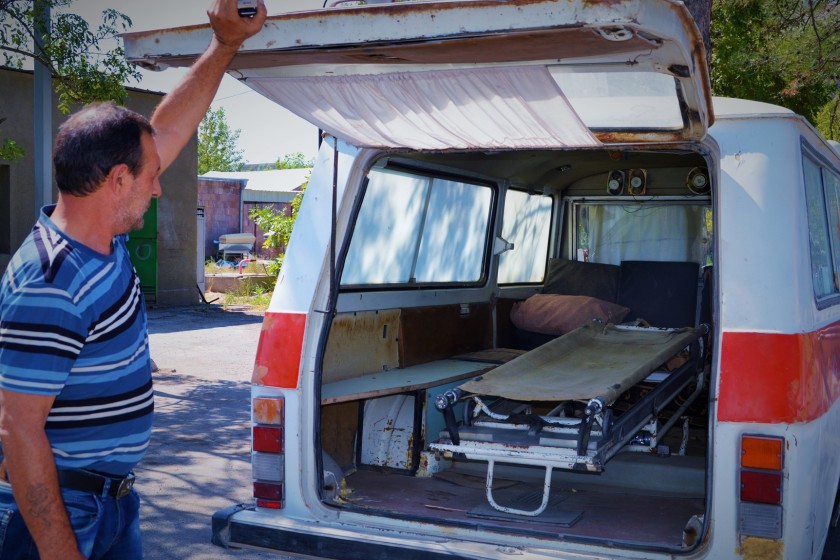
The Ambulances of Armavir Province: Some New, Some Quite Old
Tatev Khachatryan,
Grisha Balasanyan
On the evening of December 4, 2010, Armavir Aygevan village resident Vram Khlghatyan started to feel queasy and his relatives called the Armavir Medical Center for an ambulance. Those working at the ambulance station never dispatched a vehicle claiming that they were out of gasoline despite the fact that on the day the Center had vouchers for 1,500 liters of gas.
Khlghatyan died. A criminal case was launched against Nshan Gevorgyan, the Center’s director at the time. A medical examination found that Khlghatyan’s life could have been saved. Gevorgyan was found guilty of gross negligence but was pardoned under a general amnesty. He still works at the Center in another capacity.
Armavir: 8 ambulances; 5 of Soviet vintage
Four emergency teams and ten rural outpatient clinics provide emergency medical services to residents of the towns of Armavir, Metzamor, Baghramyan and Etchmiadzin in Armenia’s Armavir Province. All are equipped with ambulances.
Of the eight ambulances operating out of the Armavir Medical Center, five were produced between 1987 and1992. The other three are relatively new, manufactured between 2005 and 2008.

Armavir Medical Center Deputy Director Anahit Hayrapetyan told Hetq that their emergency unit services the town of Armavir and 37 area villages. Two of the ambulances are operating at all times on a shift basis.
Hayrapetyan claims that two vehicles are sufficient to service Armavir with a population of 29,300. She says the Center receives 35-40 emergency calls daily.

Anahit Hayrapetyan
“We can’t operate the same vehicle continuously. We’re forced to operate the old ones too. We mix up the shifts so that the new vehicles aren’t out on the same day,” says Hayrapetyan, adding that the Center diligently answers all emergency calls and that no one has ever complained.

Russian sign - Emergency medical service
Arousyak Gevorgyan (not her real name) would disagree. She tells Hetq that the Center did not dispatch an ambulance when she called several days ago. The Center said that there were no free ambulances at the time.
“They told me to take a taxi to the hospital. The person had a heart attack and couldn’t be moved. Somehow we got the patient into a car and took him to Yerevan. If the hospital here doesn’t provide adequate ambulance service I shudder to think about the quality of treatment. I’ve lost faith in them. And this isn’t the first case. I’ve heard stories from others about their poor service,” says Arousyak.
We should note that there are no professional emergency care units in Armavir Province. When necessary, such units must be called in from Yerevan.

Deputy Director Hayrapetyan says that while the Center’s ambulances can’t be compared with those operating in Yerevan, most are furnished with the necessary medical equipment except for artificial respirators. Only one ambulance is equipped with an electro-cardiogram machine. Hayrapetyan claims that gasoline shortages are a thing of the past.
Hayrapetyan told Hetq that all the Center’s ambulances are equipped with GPS devices and can be tracked at all times. Drivers of the older vehicles disputed this claim.
Many residents who spoke to Hetq claim that former director Gevorgyan used the ambulances for personal use - transporting hay from the field.
Metzamor: One ambulance for 25,000 residents
The Metzamor Medical Center has one ambulance, built in 2010, for the town itself (12,000 residents) and five surrounding villages with another 13,000 inhabitants.

Arshalouys Hambaryan, who runs the emergency services unit at Metzamor, says that the one ambulance is enough to service the six calls daily.
Hambaryan says that if the need arises, for instance if the one ambulance is transporting a patient to Yerevan, he uses his personal car to pick up emergency patients.

Arshalouys Hambaryan
Hambaryan boasts that it takes his ambulances a mere 3-4 minutes to answer a call anywhere in town but that rural calls take on average 30-40 minutes. He notes the poor condition of roads outside of town as one factor slowing down ambulances.
“The vehicle is equipped with all the equipment except a defibrillator,” says Hambaryan.

Another problem answering rural calls is the lack of street addresses in the villages. Someone has to be out in the street signaling an arriving ambulance and giving directions.
China donates modern ambulances
In 2010.under a government directive, six medical facilities in Armavir Province received ambulances. A year later, China donated 20 fully equipped ‘reanimation’ ambulances and 68 basic vehicles to Armenia. 36 of the 88 wound up in Yerevan and the rest throughout the country.

But there are still Soviet-era ambulances being used throughout Armenia’s rural areas. Most do not meet the safety and medical standards specified by Armenian law.

To be continued
 Videos
Videos Photos
Photos




Write a comment